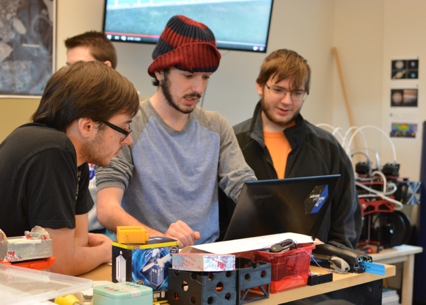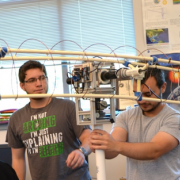Fusion Lab: Collaborative, cross-disciplinary education can expand skill sets and open career doors
October 11, 2017Visit the Fusion Lab at Capitol Technology University on any given day, and you’ll see students soldering circuits or creating form factors with a 3D printer. You’ll see them working out equations on the chalkboard, coding at computers, or strategizing ways of attracting interest and funding for their projects.
You’ll meet astronautical engineering students, and their peers from the cybersecurity program. Increasingly, you’ll also see electrical engineers, computer engineers, and students from Capitol’s business programs.
 The lab, as its name suggests, is a place where knowledge and skills from different fields can be fused in the service of engineering and technology projects. It reflects a key component of Capitol’s vision of 21st-century technology education – namely, the realization that technologists and engineers do not work in a vacuum. They collaborate, learn from each other, and broaden their individual skill sets.
The lab, as its name suggests, is a place where knowledge and skills from different fields can be fused in the service of engineering and technology projects. It reflects a key component of Capitol’s vision of 21st-century technology education – namely, the realization that technologists and engineers do not work in a vacuum. They collaborate, learn from each other, and broaden their individual skill sets.
“I’ve never had a job where I work only with people that have my degree,” says Ryan Schrenk, who founded the TRAPSat student project at Capitol and teaches in the university’s astronautical engineering program. “Yet, in many colleges, you can get very closed off. Your EEs work with EEs and your AEs work with AEs, and it’s only later, once they’re on the job, that they start to branch out.”
The Fusion Lab is part of an endeavor at Capitol to provide students with a different kind of educational experience, one that is less compartmentalized and more reflective of real-world conditions. Through the lab and other facilities, as well as through cross-curricular courses and activities, the university has made collaboration across disciplines part of its institutional culture.
 “With the employment arena becoming much more competitive, there’s an obvious advantage to starting that process much earlier, before you’ve graduated. You want to show employers that you’re well-rounded and very open to working with other people from outside your major,” Schrenk says.
“With the employment arena becoming much more competitive, there’s an obvious advantage to starting that process much earlier, before you’ve graduated. You want to show employers that you’re well-rounded and very open to working with other people from outside your major,” Schrenk says.
The TRAPSat team – part of a combined mission, known as Cactus-1, that is preparing a satellite payload for launch into space -- includes members from nearly every undergraduate degree program at Capitol. Among the team members are astronautical engineering student Marc Horvath; Alec Johnson, who is completing a dual major in software engineering and mobile computing and game programming; and Marissa Jagernath, who studies business administration.
Horvath and Johnson, who serve as the team’s co-leads for communications, say that combining their expertise not only benefits the project but strengthens their individual capabilities. “Alec has had a lot of prior experience in the military with radio signals, and that’s definitely been an asset with comms,” says Horvath. “We’ve traded a lot of skill sets. For instance, I can handle the circuitry, and since Alec has a foundation in software programing, we can get something done that, working in isolation, we wouldn’t have the skill sets to do.”
For Johnson, working on a satellite project has opened up potential employment opportunities in the space sector – opportunities he might not have considered if not for his participation in Cactus-1.
“Through this project, I’ve learned about link budgets, for instance, and about antenna deployment -- for example, how placing the antenna on one side of a CubeSat will affect how we do communications,” he says. “It’s brought me a breadth of experience, and that opens up some possibilities that I would otherwise have closed myself off to because I’m not an astronautical engineering major. As a software engineer working with Cactus-1, I can apply for space ops positions – and I plan to do so.”
Jagernath handles outreach and press relations for TRAPSat and acts as the team’s liaison with the University of Maryland’s balloon payload program. She says “not a lot of business students” get the chance to work closely with an engineering team as part of their university studies.
“I’m always learning something, and there’s always something to learn,” she says.


